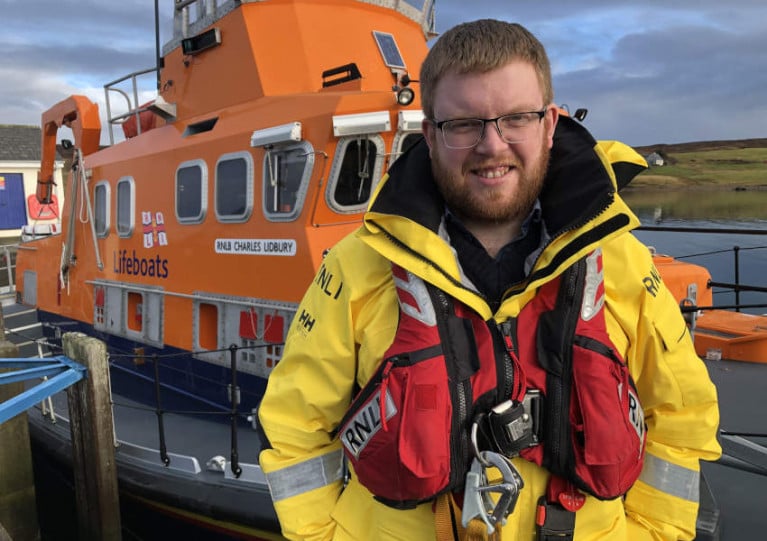Displaying items by tag: Aith
Shetland Fishing Boat Towed Off Rocks In Early Morning Rescue
A local Shetland fishing trawler is now safely back in harbour after briefly running aground near Trondra in the early hours of yesterday morning (Saturday 21 March).
The 26m whitefish trawler Sedulous had five crew on board when it went ashore around the north end of the island as it was leaving Scalloway Harbour for fishing grounds to the west of the Scalloway Islands, just after 3.30am.
Seven volunteers from Aith Lifeboat Station responded to the emergency call, and reached the site of the incident before 5.20am onboard the RNLI Charles Lidbury.
Another local trawler, the Radiant Star, was already in the area and had offered its assistance, along with Scalloway Harbour pilot boat Lyrie.
After waiting for the tide to rise, the Radiant Star crew were successful in establishing a tow line with Sedulous, and managed to pull the boat back to deeper water before any serious damage was done.
The Sedulous was then able to return to port in Scalloway under her own steam, escorted by the RNLI Charles Lidbury, and the Aith lifeboat returned to station by 8am.
Aith RNLI lifeboat coxswain John Robertson said: “Life-threatening incidents can happen at sea at any time. So it’s important that you call for help when something goes wrong.
“I’d like to thank the crew of the Radiant Star for their safe and essential assistance this morning. Their quick, competent response was an important part of getting Sedulous and her crew back to safety.
“Local RNLI crews are always ready to respond, and I’m pleased that we once again assembled so many volunteers so quickly.”
John added: “This was our first callout since the recent outbreak of the coronavirus in Shetland, at a time when many folk are self-isolating or social distancing.
“Helping slow the spread of this virus ensures that our volunteers remain healthy, and are able to keep helping save lives at sea.”
The RNLI lifeboat stationed in Aith in the Shetland Islands is to be led by local man John Robertson.
He has been appointed by the lifesaving charity as coxswain of the RNLI Charles Lidbury, the regular lifeboat stationed in the village — and will lead the volunteer crew at the most northerly lifeboat base in the UK, right on the edge of Scottish waters.
John (31), who has been the vessel’s full-time mechanic since August 2013, lives in Aith with his family, and was selected for promotion by the RNLI after formal assessments and interviews.
He has taken on the role under supervision, until his final coxswain training is completed in the coming months.
John’s years of service with the RNLI have included being called out to several notable incidents at sea.
His first ever shout was to the fatal sinking of the scallop boat Diamond near the West Burrafirth pier in March 2014, when RNLI volunteers managed to rescue a surviving crew member from the water.
He was also part of the team that attended the rescue of the Edward Henry, the crab fishing boat that was hit by a large wave west of Sumburgh in March 2017 — smashing wheelhouse windows and knocking out engines and electronics.
John and the rest of the RNLI Charles Lidbury crew spent around 14 hours at sea, escorting the damaged vessel to safety through Force 9 winds and heavy seas.
John says that the “time was right” for him to apply for the job of coxswain, and is “feeling good” about the prospect of managing the RNLI station in Aith.
His predecessor, Adam James, has moved to the north of England to take up a job as coxswain with the RNLI's operation on the Humber river near Hull.
John says: “Aith is a settled station with an experienced crew already in place. It was the trust of that crew that encouraged me to apply for the job of coxswain, and that trust is essential.
“Aith is a relatively quiet station, but our callouts tend to be serious, lengthy and often in testing weather conditions. We need to work well as a team in order to save lives at sea — and I’m really looking forward to stepping up and leading that team of committed local volunteers.
“Time is of the essence whenever we launch the RNLI Charles Lidbury, as we try to launch our lifeboat within seven minutes of our pagers going off. That can be quite a tie. I'll tend not to go any further away than Bixter, unless cover has been pre-arranged.
“But this will be a good job for me and my family, and allow me to be home about — pager depending — in between all the paperwork and maintenance that comes with running a lifeboat station.”
John is originally from Voe, but has a family connection to the lifeboat through his wife Kayla whose grandfather Frank Johnston served as lifeboat mechanic for many years, and attended the famous rescue of the crew of the Juniper trawler in February 1967.
Johnston's service that day earned him the RNLI’s Thanks of the Institution inscribed on vellum.






























































